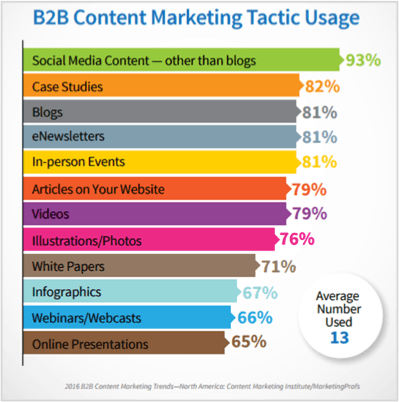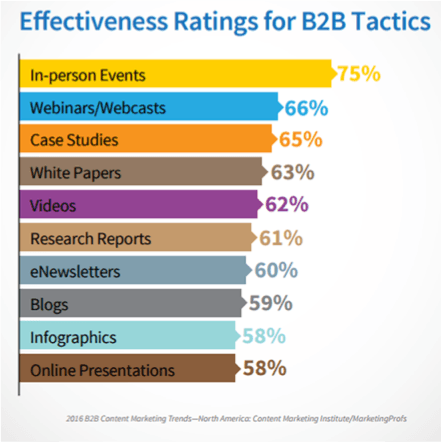We know customers today are in greater control of the relationship they have with our brands. They aren’t just passively receiving our marketing; they’re actively consuming related content (that we may have played no role in crafting) in social media and other channels.
In a marketplace that’s become crowded with new types of information in new channels, is there still a role for case studies and testimonials? And if they do still belong in our content mix, how can we make them more effective?
Nothing beats a good story well told.
Recent research indicates that case studies are still a popular and effective tactic. In the new B2B Content Marketing Benchmarks, Budgets, and Trends—North America 2016 report (by Content Marketing Institute and MarketingProfs), B2B marketers said case studies are their second most popular tactic…
… and their third most effective tactic, losing second place to “Webinars/Webcasts” by a whisker.
Marketers responding to a LinkedIn survey ranked case studies even higher; 89% said case studies are their most effective tactic. And they said the most important elements of effective content are audience relevance and engaging and compelling storytelling.
So how do you develop case studies that are relevant, engaging, and compelling?
When I write a case study, I try to employ the storytelling techniques I learned at USC film school – the same ones good screenwriters use when they’re making unforgettable movies.
- Draw an authentic world. The place in which a story occurs is as important as the characters in it. Think about the austere homes in Woody Allen’s Interiors, or the harsh landscapes in the Mad Max movies, or the moist jungle of Avatar. And you don’t need lengthy descriptions, just a few well-chosen details about your customer’s workplace or culture or anything that is unique about their business. If you see it in your mind, your readers will see it in theirs.
- Make the objectives clear. It’s riveting to watch someone chase a dream, and it doesn’t have to be a lofty one. Becoming school president may seem like trivial premise, but it makes Election a great movie because Reese Witherspoon’s character wants it so badly. Your customers care about their goals. If your readers know why, they will care, too.
- Let your audience know what’s at stake. The more a character stands to lose, the more gripping the film. The same is true for your case study. The clearer your customer’s price of failure is, the more your readers will want her to succeed. And they’ll attribute some of that success to your product when she does.
- Make the obstacles real and hard. The more a character struggles, the more we want her to win – especially when we can relate to those struggles. Make sure your readers know all the reasons your customer’s goal is difficult to achieve, and describe them in ways your readers can identify with. Then when your customer triumphs because of your product, your readers will feel empowered, too.
Happy customers are still your best evangelists.

Customer testimonials have always been a highly effective way to underscore your company’s credibility and the value of your products.
They are powerful influencers because your prospects believe their peers. And they remain potent.
In a Nielsen survey published in September, 83% of respondents say they completely or somewhat trust the recommendations of friends and family. And a full two-thirds said they trust consumer opinions posted online.
How can you leverage this power?
Let your customers generate their own testimonials.
According to a white paper published by Baazar Voice, 51% of Americans trust user-generated content (UCG) more than other sources of information. And age doesn’t seem to be a factor. Eighty-four percent of Millenials and 70% of Baby Boomers say that UGC on company websites has at least some influence on what they buy.
Gathering UGC testimonials is a lot easier than it might seem, thanks to the availability of software that automates the process.
Packages like Vocal References provide all the tools you need to capture and approve testimonials, and post them to your web site and social media. Boast is another package that does all this, plus gives you the ability to track your content’s effectiveness. The testimonials you collect can be in video or text format.
For a brief overview of the process, watch the short video How to Collect Testimonials Automatically.
Get everyone in your company to help you.
You can also get testimonials the old-fashioned way – by asking for them. Your sales and support teams speak to your customers regularly, often on service-based calls or at industry events when the objective of their conversations is to solicit feedback. With a little planning, you can take advantage of these exchanges.
- Train staff to elicit a good testimonial. Have them ask customers how well your product is delivering on your brand promise, and make sure they recognize when a response confirms your product’s value proposition.
- Implement ways to collect the feedback. Instruct your teams to request permission for you to follow up with a customer, and give them an easy way to facilitate that. They can jot a note on the back of a customer’s business card and give it to you later, or record their exchange in the customer’s account and assign you a task.
- Reward everyone involved. Acknowledge employees who collect testimonials. Praise them in meetings, or offer a small prize each month to the one who collects the most. Give your customers a thank you gift, or if it’s visibility they value, display the testimonials in way that ensures both they and their companies are easy to identify.
Keep in mind that regardless of how you collect testimonials, the more strategically you place them, the harder they work for you. Be sure to present them in locations where their content can reduce any anxiety you think a prospect might be experiencing at that moment.
For example, next to a detailed list of your software’s features, include a testimonial that praises the free resources you offer to help customers quickly get up to speed. Or when a prospect is moving through an online purchase, display a quote from a customer who said the money he spent on your product was “the best investment he ever made.”
The rise of video
If you’re not already using video to present your case studies and testimonials, now is the time to consider it. Invodo complied some eye-opening statistics in their white paper on video marketing:
- 74% of all Internet traffic in 2017 will be video.
- Retention rate for visual information can reach 65%, vs. 10% for text-based information.
- Shoppers who view video are almost twice as likely to purchase than non-viewers.
- Retailers cite 40% increases in purchases as a result of video.
If you take another look at the screenwriting tips I offered above, you can see why video is a powerful format for both case studies and testimonials. By design, video immerses prospects directly into the world of your customer. And because it gives them a firsthand view of a customer sharing his goals, discussing his obstacles, and worrying about failing, it allows them to more deeply identify with the solution your product offers.
Final Takeaway
With prospects explicitly driving the evaluation process, we need to be more thoughtful about the content we create, and more diligent about ensuring it has meaning for them. If we’re sensitive to how we develop case studies and testimonials, they can be an effective way for our companies to meet our prospects on their self-guided journeys – and shape the direction they take.
Case studies and testimonials are powerful tools to help engage your prospects when used correctly. Take a look at Act-On’s free toolkit – 4 Steps to Develop a Content Plan, to help you effectively plan where to use testimonials in your content plan.


